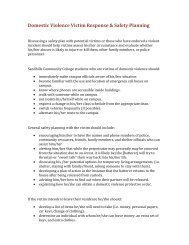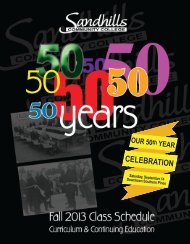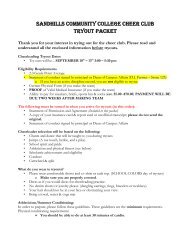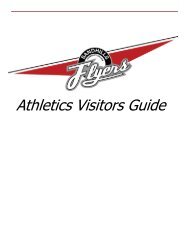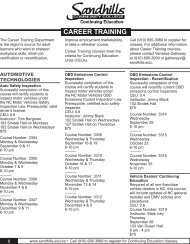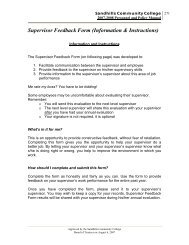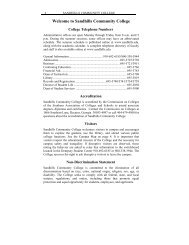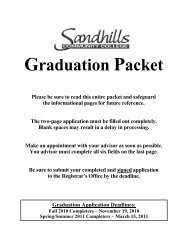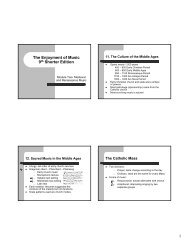Web Style Guide: TYPOGRAPHY - Sandhills Community College
Web Style Guide: TYPOGRAPHY - Sandhills Community College
Web Style Guide: TYPOGRAPHY - Sandhills Community College
You also want an ePaper? Increase the reach of your titles
YUMPU automatically turns print PDFs into web optimized ePapers that Google loves.
<strong>Web</strong> <strong>Style</strong> <strong>Guide</strong>: <strong>TYPOGRAPHY</strong><br />
<strong>TYPOGRAPHY</strong><br />
Typography exists to honor content.<br />
— Robert Bringhurst, The Elements of Typographic <strong>Style</strong><br />
<strong>TYPOGRAPHY</strong> is the balance and interplay of letterforms on the page, a verbal and visual equation that<br />
helps the reader understand the form and absorb the substance of the page content. Typography plays a<br />
dual role as both verbal and visual communication. As readers scan a page they are subconsciously<br />
aware of both functions: first they survey the overall graphic patterns of the page, then they parse the<br />
language, or read. Good typography establishes a visual hierarchy for rendering prose on the page by<br />
providing visual punctuation and graphic accents that help readers understand relations between prose<br />
and pictures, headlines and subordinate blocks of text.<br />
Characteristics of type on the <strong>Web</strong><br />
Although the basic rules of typography are much the same for both <strong>Web</strong> pages and conventional print<br />
documents, type on-screen and type printed on paper are different in crucial ways. The computer screen<br />
renders typefaces at a much lower resolution than is found in books, magazines, and even pages output<br />
from inexpensive printers. Most magazine and book typography is rendered at 1200 dots per inch (dpi)<br />
or greater, whereas computer screens rarely show more than about 85 dpi. Also, the useable area of<br />
typical computer screens is smaller than most magazine and book pages, limiting the information you<br />
can deliver on a <strong>Web</strong> page without scrolling.<br />
But perhaps the most distinctive characteristic of <strong>Web</strong> typography is its variability. <strong>Web</strong> pages are built<br />
on the fly each time they are loaded into a <strong>Web</strong> browser. Each line of text, each headline, each unique<br />
font and type style is re-created by a complex interaction of the <strong>Web</strong> browser, the <strong>Web</strong> server, and the<br />
operating system of the reader's computer. The process is fraught with possibilities for the unexpected: a<br />
missing font, an out-of-date browser, or a peculiar set of font preferences designated by the reader. You<br />
should regard your <strong>Web</strong> page layouts and typography as suggestions of how your pages should be<br />
rendered — you'll never know exactly how they will look on the reader's screen.<br />
http://webstyleguide.com/type/print/type.html (1 of 31)5/17/2005 5:18:39 PM
<strong>Web</strong> <strong>Style</strong> <strong>Guide</strong>: <strong>TYPOGRAPHY</strong><br />
www.chronicle.com<br />
Content structure and visual logic<br />
The originators of HTML were scientists who wanted a standard means to share particle physics<br />
documents. They had little interest in the exact visual form of the document as seen on the computer<br />
screen. In fact, HTML was designed to enforce a clean separation of content structure and graphic<br />
design. The intent was to create a World Wide <strong>Web</strong> of pages that will display in every system and<br />
browser available, including browsers that "read" <strong>Web</strong> page text to visually impaired users and can be<br />
accurately interpreted by automated search and analysis engines.<br />
In casting aside the graphic design and editorial management traditions of publishing, the original<br />
designers of the <strong>Web</strong> ignored human motivation. They were so concerned about making <strong>Web</strong> documents<br />
machine-friendly that they produced documents that only machines (or particle physicists) would want<br />
to read. In focusing solely on the structural logic of documents they ignored the need for the visual logic<br />
of sophisticated graphic design and typography.<br />
For example, most graphic designers avoid using the standard heading tags in HTML (H1, H2, and so<br />
http://webstyleguide.com/type/print/type.html (2 of 31)5/17/2005 5:18:39 PM
<strong>Web</strong> <strong>Style</strong> <strong>Guide</strong>: <strong>TYPOGRAPHY</strong><br />
on) because they lack subtlety: in most <strong>Web</strong> browsers these tags make headlines look absurdly large<br />
(H1, H2) or ridiculously small (H4, H5, H6). But the header tags in HTML were not created with<br />
graphic design in mind. Their sole purpose is to designate a hierarchy of headline importance, so that<br />
both human readers and automated search engines can look at a document and easily determine its<br />
information structure. Only incidentally did browser designers create a visual hierarchy for HTML<br />
headers by assigning different type sizes and levels of boldness to each header element.<br />
Cascading style sheets<br />
This division between structural logic and visual logic is on its way to being reconciled through the use<br />
of Cascading <strong>Style</strong> Sheets (CSS). <strong>Style</strong> sheets provide control over the exact visual style of headers,<br />
paragraphs, lists, and other page elements. For example, if you prefer H3 headers to be set in 12-point<br />
Arial bold type, you can specify those details in a style sheet. In this way you can retain the logical use<br />
of HTML's structural tags without sacrificing graphic design flexibility.<br />
At this writing, however, the major <strong>Web</strong> browsers offer inconsistent and incomplete CSS support.<br />
Although both Microsoft Internet Explorer version 3.0 and higher and Netscape Navigator version 4.0<br />
and higher support CSS, their exact implementations of it differ. A most frustrating example of this is<br />
the margin property. Standard HTML headings float far above the paragraphs they describe. With style<br />
sheets authors can designate more suitable margins in a heading style declaration. Yet the Netscape<br />
browser adds the designated amount to the standard margin, whereas Explorer simply adds the margin<br />
defined in the style sheet. The upshot is that until the browsers offer a more consistent implementation<br />
of CSS, only a handful of properties can be used reliably.<br />
http://webstyleguide.com/type/print/type.html (3 of 31)5/17/2005 5:18:39 PM
<strong>Web</strong> <strong>Style</strong> <strong>Guide</strong>: <strong>TYPOGRAPHY</strong><br />
www.chronicle.com<br />
So what do you do when you know the advantages of preserving the document structure but you want to<br />
design <strong>Web</strong> pages that are attractive and functional enough to capture and sustain an audience? You<br />
compromise. In the sites we create we use a grab bag of tricks to present as polished and sophisticated a<br />
page design as we can manage within the boundaries of "official" HTML. We use no proprietary HTML<br />
tags, such as those specific to Internet Explorer or Netscape Navigator. Our approach to typography<br />
emphasizes visual design over structural purity. Wherever possible, we use "plain vanilla" HTML to<br />
describe document structure and CSS to define visual layout. We do not strive for complete control and<br />
consistency for our pages but instead accept a certain degree of variability between platforms and<br />
browsers. Where CSS falls short, however, we dip into our grab bag of tricks rather than sacrifice visual<br />
integrity. We believe that this is the best compromise until everyone can shift over to a mature<br />
implementation of CSS and leave plain HTML behind.<br />
Advantages of CSS<br />
http://webstyleguide.com/type/print/type.html (4 of 31)5/17/2005 5:18:39 PM
<strong>Web</strong> <strong>Style</strong> <strong>Guide</strong>: <strong>TYPOGRAPHY</strong><br />
This book is not a manual on HTML, and covering the full design implications of Cascading <strong>Style</strong><br />
Sheets is well beyond the scope of this chapter. If you are not using CSS to manage the graphic design<br />
of your <strong>Web</strong> site, however, you should at least be planning a transition to CSS technology within the<br />
next year.<br />
Cascading <strong>Style</strong> Sheets offer <strong>Web</strong> designers two key advantages in managing complex <strong>Web</strong> sites:<br />
●<br />
●<br />
Separation of content and design. CSS gives site developers the best of both worlds: content<br />
markup that reflects the logical structure of the information and the freedom to specify exactly<br />
how each HTML tag will look.<br />
Efficient control over large document sets. The most powerful implementations of CSS will<br />
allow site designers to control the graphic "look and feel" of thousands of pages by modifying a<br />
single master style sheet document.<br />
<strong>Style</strong> sheets provide greater typographic control with less code. Using plain HTML, you need to define<br />
the physical properties of an element such as the tag each time you use it.<br />
Section heading<br />
When you define these properties using CSS, that single definition, or rule, applies to every instance of<br />
the element in all documents that reference the style sheet.<br />
H1 { text-align: center; font-size: 16pt; font-family: Verdana, Helvetica, Arial, sansserif;<br />
color: gray }<br />
In addition, style sheets offer more formatting options than plain HTML tags and extensions. For<br />
example, interline spacing, or leading, can be controlled using style sheets, as can such text properties as<br />
letterspacing and background color. And fortunately the text formatting properties are implemented well<br />
enough across browsers to be used with some consistency.<br />
How style sheets work<br />
<strong>Style</strong> sheets are not new. Every graphic <strong>Web</strong> browser (even back to Mosaic 1.0) has incorporated style<br />
http://webstyleguide.com/type/print/type.html (5 of 31)5/17/2005 5:18:39 PM
<strong>Web</strong> <strong>Style</strong> <strong>Guide</strong>: <strong>TYPOGRAPHY</strong><br />
sheets. It just wasn't possible to modify the fixed styles that browsers used to determine, for example,<br />
exactly how H1 headers look on the screen. The fundamental idea behind CSS is to let site authors and<br />
users determine the size, style, and layout details for each standard HTML tag.<br />
If you have ever used the "styles" features of a page layout or word processing program, you will<br />
understand the basic idea behind CSS. The styles feature of a word processor is used to determine<br />
exactly how your titles, subheadings, and body copy will look, and then the copy is formatted when you<br />
apply a style to each element. Once all the copy has been styled, you can change the look of each<br />
occurrence of every element simply by changing the style information. CSS works in the same way,<br />
except that with CSS you can set up one master style sheet that will control the visual styling of every<br />
page in your site that is linked to the master style sheet:<br />
info.med.yale.edu/caim/hhmi<br />
http://webstyleguide.com/type/print/type.html (6 of 31)5/17/2005 5:18:39 PM
<strong>Web</strong> <strong>Style</strong> <strong>Guide</strong>: <strong>TYPOGRAPHY</strong><br />
Legibility<br />
Good typography depends on the visual contrast between one font and another and between text blocks,<br />
headlines, and the surrounding white space. Nothing attracts the eye and brain of the reader like strong<br />
contrast and distinctive patterns, and you can achieve those attributes only by carefully designing them<br />
into your pages. If you cram every page with dense text, readers see a wall of gray and will instinctively<br />
reject the lack of visual contrast. Just making things uniformly bigger doesn't help. Even boldface fonts<br />
quickly become monotonous, because if everything is bold then nothing stands out "boldly."<br />
When your content is primarily text, typography is the tool you use to "paint" patterns of organization on<br />
the page. The first thing the reader sees is not the title or other details on the page but the overall pattern<br />
and contrast of the page. The regular, repeating patterns established through carefully organized pages of<br />
text and graphics help the reader to establish the location and organization of your information and<br />
increase legibility. Patchy, heterogeneous typography and text headers make it hard for the user to see<br />
repeating patterns and almost impossible to predict where information is likely to be located in<br />
unfamiliar documents:<br />
Alignment<br />
Margins define the reading area of your page by separating the main text from the surrounding<br />
environment. Margins provide important visual relief in any document, but careful design of margins<br />
http://webstyleguide.com/type/print/type.html (7 of 31)5/17/2005 5:18:39 PM
<strong>Web</strong> <strong>Style</strong> <strong>Guide</strong>: <strong>TYPOGRAPHY</strong><br />
and other "white space" is particularly important in <strong>Web</strong> page design because <strong>Web</strong> content must coexist<br />
on the computer screen with the interface elements of the browser itself and with other windows, menus,<br />
and icons of the user interface.<br />
argus-acia.com<br />
Margins and space can be used to delineate the main text from the other page elements. And when used<br />
consistently, margins provide unity throughout a site by creating a consistent structure and look to the<br />
site pages. They also add visual interest by contrasting the positive space of the screen (text, graphics)<br />
from the negative (white) space.<br />
Text blocks have different ways of sitting within margins. Left-justified, centered, right-justified, and<br />
justified text are the alignment options available on the <strong>Web</strong>.<br />
Justified text<br />
Justified text is set flush with the left and right margins. Justified blocks of text create solid rectangles,<br />
and block headings are normally centered for a symmetrical, formal-looking document. In print,<br />
justification is achieved by adjusting the space between words and by using word hyphenation. Page<br />
http://webstyleguide.com/type/print/type.html (8 of 31)5/17/2005 5:18:39 PM
<strong>Web</strong> <strong>Style</strong> <strong>Guide</strong>: <strong>TYPOGRAPHY</strong><br />
layout programs use a hyphenation dictionary to check for and apply hyphenation at each line's end and<br />
then adjust word spacing throughout the line. But even with sophisticated page layout software, justified<br />
text blocks often suffer from poor spacing and excessive hyphenation and require manual refinement.<br />
This level of control is not even a remote possibility on <strong>Web</strong> pages. The most recent browser versions<br />
(and CSS) support justified text, but it is achieved by crude adjustments to word spacing. Fine<br />
adjustments are not possible on low-resolution computer displays and are impractical to implement in<br />
today's <strong>Web</strong> browsers. Also, <strong>Web</strong> browsers are unlikely to offer automatic hyphenation any time soon,<br />
another "must" for properly justified text. For the foreseeable future, the legibility of your <strong>Web</strong><br />
documents will suffer if you set your text in justified format.<br />
Centered and right-justified text blocks<br />
Centered and right-justified text blocks are difficult to read. We read from left to right, anchoring our<br />
tracking across the page at the vertical line of the left margin. The ragged left margins produced by<br />
centering or right-justifying text make that scanning much harder, because your eye needs to search for<br />
the beginning of each new line.<br />
Left-justified text<br />
Left-justified text is the most legible option for <strong>Web</strong> pages because the left margin is even and<br />
predictable and the right margin is irregular. Unlike justified text, left justification requires no<br />
adjustment to word spacing; the inequities in spacing fall at the end of the lines. The resulting "ragged"<br />
right margin adds variety and interest to the page without interfering with legibility.<br />
http://webstyleguide.com/type/print/type.html (9 of 31)5/17/2005 5:18:39 PM
<strong>Web</strong> <strong>Style</strong> <strong>Guide</strong>: <strong>TYPOGRAPHY</strong><br />
Justification of headlines<br />
Titles and headings over left-justified body text should also be flush left. Centered headings pair well<br />
with justified text, but justified text should not be used on <strong>Web</strong> pages. Centered display type contrasts<br />
with the asymmetry of the ragged right margin of left-justified body text and produces an unbalanced<br />
page.<br />
http://webstyleguide.com/type/print/type.html (10 of 31)5/17/2005 5:18:39 PM
<strong>Web</strong> <strong>Style</strong> <strong>Guide</strong>: <strong>TYPOGRAPHY</strong><br />
Until typographic options for <strong>Web</strong> pages become more sophisticated, we recommend that you use leftjustified<br />
text blocks and headlines as the best solution for most layout situations.<br />
Line length<br />
Text on the computer screen is hard to read not only because of the low resolution of computer screens<br />
but also because the layout of most <strong>Web</strong> pages violates a fundamental rule of book and magazine<br />
typography: the lines of text on most <strong>Web</strong> pages are far too long for easy reading. Magazine and book<br />
columns are narrow for physiological reasons: at normal reading distances the eye's span of acute focus<br />
is only about three inches wide, so designers try to keep dense passages of text in columns not much<br />
wider than that comfortable eye span. Wider lines of text require readers to move their heads slightly or<br />
strain their eye muscles to track over the long lines of text. Readability suffers because on the long trip<br />
back to the left margin the reader may lose track of the next line.<br />
You can use invisible tables (BORDER="0") to restrict the text line length to about fifty to seventy<br />
characters per line (see Page Design, Page layout). The exact character count is difficult to predict<br />
because of the way different browser software and operating systems display type sizes. In conventional<br />
print layouts, columns of thirty to forty characters per line are considered ideal.<br />
In the end, the decision to restrict line length is a philosophical one. From a design standpoint, a measure<br />
that is comfortable for reading is good practice. One of the fundamental principles of the <strong>Web</strong>, however,<br />
is that users should be able to structure their own view. Users with a large monitor may not want their<br />
text blocks circumscribed if it means that a large portion of their screen goes unused. A low-vision user<br />
with fonts set large will not appreciate being forced to view long pages with short lines of text. So<br />
although leaving text free to fill the browser window may affect readability, following conventions may<br />
also affect the accessibility and legibility of your documents.<br />
http://webstyleguide.com/type/print/type.html (11 of 31)5/17/2005 5:18:39 PM
<strong>Web</strong> <strong>Style</strong> <strong>Guide</strong>: <strong>TYPOGRAPHY</strong><br />
www.dartmouth.edu/~wug and www-3.ibm.com/ibm/easy<br />
When designing a fixed-width layout, we typically use page layout tables with text cells no wider than<br />
about 365 pixels. If 12-point Times New Roman type is used, this cell width yields a line about fifty<br />
characters long, averaging about nine to ten words per line. We believe that this achieves the best<br />
http://webstyleguide.com/type/print/type.html (12 of 31)5/17/2005 5:18:39 PM
<strong>Web</strong> <strong>Style</strong> <strong>Guide</strong>: <strong>TYPOGRAPHY</strong><br />
balance between space efficiency and legibility. If you choose a flexible layout approach, use CSS<br />
leading controls to increase line spacing to 15 or 16 points (see White space). Additional line spacing<br />
allows a somewhat longer line length without sacrificing legibility.<br />
White space<br />
The vertical space in a text block is called leading, and it is the distance from one baseline of text to the<br />
next. Leading strongly affects the legibility of text blocks: too much leading makes it hard for the eye to<br />
locate the start of the next line, whereas too little leading confuses the lines of type, because the<br />
ascenders of one line get jumbled with the descenders of the line above. In plain HTML it is not possible<br />
to implement true leading, but CSS offers leading control (referred to as "line spacing" in CSS<br />
terminology). In print one general rule is to set the leading of text blocks at about 2 points above the size<br />
of the type. For example, 12-point type could be set with 14 points of leading. We suggest generous<br />
leading to compensate for longer line lengths and the lower resolution of the computer screen, for<br />
example, 12-point type with 14 to 16 points of leading.<br />
Indenting paragraphs<br />
There are two major schools of thought on denoting paragraphs. The classic typographic method uses<br />
indents to signal the beginning of a new paragraph (as we have in this book). However, many technical,<br />
reference, and trade publications now use a blank line of white space to separate paragraphs. Indented<br />
paragraphs work especially well for longer blocks of prose, where the indents signal new paragraphs<br />
with minimal disruption to the flow of text. Blank line spacing between paragraphs, in contrast, makes a<br />
page easy to scan and provides extra white space for visual relief. Either approach is valid as long as the<br />
paragraph style is implemented consistently throughout the site.<br />
To indent paragraphs without using CSS, you can insert several non-breaking space characters ( )<br />
at the start of each paragraph. You can also use a transparent single-pixel GIF graphic as a spacer and<br />
adjust its horizontal spacing. If you are using CSS you can set the exact spacing for the indentation using<br />
the "text-indent" property of paragraphs.<br />
To indent paragraphs without using CSS, ...<br />
To indent<br />
paragraphs without using CSS, ...<br />
To indent paragraphs without using CSS, ...<br />
http://webstyleguide.com/type/print/type.html (13 of 31)5/17/2005 5:18:39 PM
<strong>Web</strong> <strong>Style</strong> <strong>Guide</strong>: <strong>TYPOGRAPHY</strong><br />
To separate paragraphs with blank lines you could put a paragraph tag () at the end of each<br />
paragraph. The paragraph tag adds a full blank line between paragraphs. To adjust the amount to an<br />
amount less or more than a full blank line you can use the CSS "margin" property, but beware of spacing<br />
inconsistencies between browsers. You can also use the line break tag () followed by a transparent<br />
single-pixel GIF graphic as a spacer to control the space between paragraphs. As always when using a<br />
spacer graphic, be sure to include empty ALT text to hide the image from assistive technologies and textonly<br />
browsers:<br />
<br />
<br />
Typefaces<br />
Each typeface has a unique tone that should produce a harmonious fit between the verbal and visual flow<br />
of your content. With the first versions of HTML, <strong>Web</strong> authors had no control over typefaces ("fonts" in<br />
personal computer terminology). Fonts were set by the browser, so pages were viewed in whatever font<br />
the user specified in his or her browser preferences. The more recent versions of HTML and CSS allow<br />
designers to specify the typeface. This is useful not only for aesthetic reasons but also because of the<br />
differing dimensions of typefaces. A layout that is carefully designed using one face may not format<br />
correctly in another.<br />
In specifying typefaces you should choose from the resident default fonts for most operating systems. If<br />
you specify a font that is not on the user's machine, the browser will display your pages using the userspecified<br />
default font. Bear in mind, too, that users can set their browser preferences to ignore font tags<br />
and display all pages using their designated default font.<br />
Legibility on screen<br />
Some typefaces are more legible than others on the screen. A traditional typeface such as Times Roman<br />
is considered to be one of the most legible on paper, but at screen resolution its size is too small and its<br />
shapes look irregular. Screen legibility is most influenced by the x-height (the height of a lowercase "x")<br />
and the overall size of the typeface.<br />
Adapted traditional typefaces<br />
http://webstyleguide.com/type/print/type.html (14 of 31)5/17/2005 5:18:39 PM
<strong>Web</strong> <strong>Style</strong> <strong>Guide</strong>: <strong>TYPOGRAPHY</strong><br />
Times New Roman is a good example of a traditional typeface that has been adapted for use on<br />
computer screens. A serif typeface like Times New Roman (the default text face in most <strong>Web</strong> browsers)<br />
is about average in legibility on the computer screen, with a moderate x-height. Times New Roman is a<br />
good font to use in text-heavy documents that will probably be printed by readers rather than read from<br />
the screen. The compact letter size of Times New Roman also makes it a good choice if you need to<br />
pack a lot of words into a small space.<br />
Designed for the screen<br />
Typefaces such as Georgia and Verdana were designed specifically for legibility on the computer<br />
screen; they have exaggerated x-heights and are very large compared to more traditional typefaces in the<br />
same point size. These fonts offer excellent legibility for <strong>Web</strong> pages designed to be read directly from<br />
the screen. However, the exaggerated x-heights and heavy letterforms of these fonts look massive and<br />
clumsy when transferred to the high-resolution medium of paper.<br />
Choosing typefaces<br />
The most conventional scheme for using typefaces is to use a serif face such as Times New Roman or<br />
Georgia for body text and a sans serif face such as Verdana or Arial as a contrast for headlines. We<br />
generally set our text-laden <strong>Web</strong> pages in Times New Roman because it produces a reasonable balance<br />
between density of information and overall legibility. Most readers expect a serif font for long blocks of<br />
text and find Times New Roman comfortable to read off-screen from paper printouts. Various studies<br />
purport to show that serif type is more legible than sans serif type and vice versa. You can truly judge<br />
type legibility only within the context of the situation — on the screen — as users will see your <strong>Web</strong><br />
page.<br />
You may use either a variation of the serif font or a contrasting sans serif face for the display type. It is<br />
safest to use a single typographic family and vary its weight and size for display type and emphasis. If<br />
you choose to combine serif and sans serif faces, select fonts that are compatible and don't use more than<br />
two typefaces (one serif, one sans serif) on a page.<br />
The most useful fonts that ship with the Apple Macintosh and Microsoft Windows operating systems are<br />
reproduced here (we have omitted bitmap fonts and decorative or novelty typefaces):<br />
http://webstyleguide.com/type/print/type.html (15 of 31)5/17/2005 5:18:39 PM
<strong>Web</strong> <strong>Style</strong> <strong>Guide</strong>: <strong>TYPOGRAPHY</strong><br />
Specifying typefaces<br />
http://webstyleguide.com/type/print/type.html (16 of 31)5/17/2005 5:18:39 PM
<strong>Web</strong> <strong>Style</strong> <strong>Guide</strong>: <strong>TYPOGRAPHY</strong><br />
The early versions of HTML did not allow designers to specify a typeface for <strong>Web</strong> documents. With<br />
version 3.2 came several new tags aimed at giving designers more control over the visual properties of<br />
elements, among them the FONT tag. Many of these have been "deprecated" by the World Wide <strong>Web</strong><br />
Consortium, which means that they may be dropped from future versions of HTML. Although the added<br />
tags enable designers to create more elegant-looking pages, they also result in cumbersome code that is<br />
difficult to adapt and maintain. You can still use the FONT tag to set the type in your documents, but a<br />
better approach is to consolidate text formatting in style sheets.<br />
You can specify any typeface for your <strong>Web</strong> pages, but many computers have only the default operating<br />
system fonts installed. If the typeface you specify is not available on the user's computer, the browser<br />
will switch to the default font (generally "Times New Roman" or "Times"). To increase the chances that<br />
the reader will see a typeface you are happy with, you can specify multiple fonts. The browser will<br />
check for the presence of each font (in the order given), so you can specify three or four alternates<br />
before the browser applies the default font, for example, "Verdana, Geneva, Arial, Helvetica." As a lastditch<br />
effort you can end your font declaration with a generic font designation such as "sans serif." That<br />
way, if the browser cannot find any of the listed fonts, it will display the text in any available sans serif<br />
font.<br />
P { font-family: "Times New Roman", Georgia, Times, serif }<br />
Notice that multiword fonts like "Times New Roman" must appear within quotation marks.<br />
A good way to make sure that your type settings are functioning correctly is to set your browser's default<br />
proportional font setting to something that is obviously different from your intended font. For example,<br />
set your browser's default font to Courier if you are not using Courier in your document. When you view<br />
your page, anything that appears in Courier must not be marked up properly.<br />
Type size<br />
Setting the size of type is a matter of some controversy. The <strong>Web</strong> is supposed to be a universal medium<br />
where users of all kinds have equal access to information. As opposed to a printed medium, where the<br />
layout and type are fixed, <strong>Web</strong> pages should adapt to meet the needs of all comers, so that, for example,<br />
low-vision users can set the type of <strong>Web</strong> documents to display at a size that they find legible. But these<br />
adjustments can skew a page layout and send the designer, who diligently designed the page around a<br />
specific size of type, into paroxysms. And though variation thwarts the designer who worked to fashion<br />
http://webstyleguide.com/type/print/type.html (17 of 31)5/17/2005 5:18:39 PM
<strong>Web</strong> <strong>Style</strong> <strong>Guide</strong>: <strong>TYPOGRAPHY</strong><br />
the layout, it is undeniable that the low-vision user ought to be able to gain access to the content.<br />
With the introduction of the FONT tag, designers also gained the ability to set the font size. With CSS,<br />
designers have many methods for setting type size, although, as with many other CSS properties, all are<br />
not fully supported. The W3C recommends that you let users set the base font size in their browser and<br />
that you set all variations using the "em" unit. An em in the <strong>Web</strong> context is the same as the font height,<br />
which makes it a relative unit and therefore flexible. For example, if the user-set default is 12-point, then<br />
a 2-em text indent would be 24-point, but if the user used the text zoom feature of the browser to change<br />
the size to 16-point, the indent would change to 32-point to reflect the larger type size.<br />
P { font-family: Verdana, Arial, Helvetica, sans-serif; font-size: 1em; text-indent:<br />
2em }<br />
As you might imagine, this flexibility can send page layouts into disarray. If you try this approach, use a<br />
flexible page layout that will hold up to large type.<br />
enterprise.cnet.com<br />
http://webstyleguide.com/type/print/type.html (18 of 31)5/17/2005 5:18:39 PM
<strong>Web</strong> <strong>Style</strong> <strong>Guide</strong>: <strong>TYPOGRAPHY</strong><br />
You can also use points to define your type sizes, but bear in mind that this carryover from the print<br />
medium has little meaning on a computer screen. Because monitors display at different resolutions, 12-<br />
point type on one screen could approximate 14-point type on another. This can be particularly<br />
problematic for small point sizes. For example, 6-point type is legible on a Windows display, where the<br />
default resolution is 96 ppi, but on a Macintosh, at 72 ppi, it is illegible.<br />
www.educateu.com<br />
Still, points are familiar and, though variable, offer some means of declaring the relative size of type<br />
http://webstyleguide.com/type/print/type.html (19 of 31)5/17/2005 5:18:39 PM
<strong>Web</strong> <strong>Style</strong> <strong>Guide</strong>: <strong>TYPOGRAPHY</strong><br />
elements.<br />
H1 { font-family: Verdana, Arial, Helvetica, sans-serif; font-size: 14 pt }<br />
P { font-family: Georgia, "Times New Roman", Times, serif; font-size: 12 pt }<br />
Just remember that declaring your type in points does not mean that the point size you specify is what<br />
will actually display on the user's monitor. And because this unit is not "fixed" — that is, type set in<br />
points can be resized in the browser — this approach also requires an adaptable layout.<br />
If the integrity of your layout depends on specific type sizes, the most dependable option right now —<br />
until there is better CSS support — is to use pixel units in your style declarations. Text defined using<br />
pixels will be the same size regardless of the browser's default font size and resolution settings.<br />
P { font-family: Georgia, "Times New Roman", serif; font-size: 12px }<br />
Although this option does offer more stability, be aware that you may be shutting out those users who<br />
have good reasons for specifying different font settings.<br />
Case<br />
Whether you choose uppercase or lowercase letters has a strong effect on the legibility of your text.<br />
Indeed, words set in all uppercase letters should generally be avoided — except perhaps for short<br />
headings — because they are difficult to scan.<br />
We read primarily by recognizing the overall shape of words, not by parsing each letter and then<br />
assembling a recognizable word:<br />
Words formed with capital letters are monotonous rectangles that offer few distinctive shapes to catch<br />
the eye:<br />
http://webstyleguide.com/type/print/type.html (20 of 31)5/17/2005 5:18:39 PM
<strong>Web</strong> <strong>Style</strong> <strong>Guide</strong>: <strong>TYPOGRAPHY</strong><br />
We recommend downstyle typing (capitalize only the first word and any proper nouns) for your<br />
headlines, subheads, and text. Downstyle is more legible because as we read we primarily scan the tops<br />
of words:<br />
Notice how much harder it is to read the bottom half of the same sentence:<br />
If you use initial capital letters in your headlines, you disrupt the reader's scanning of the word forms:<br />
Emphasis<br />
A <strong>Web</strong> page of solid body text is hard to scan for content structure and will not engage the eye. Adding<br />
display type to a document will provide landmarks to direct the reader through your content. Display<br />
type establishes an information structure and adds visual variety to draw the reader into your material.<br />
The key to effective display type is the careful and economic use of typographic emphasis.<br />
There are time-honored typographical devices for adding emphasis to a block of text, but be sure to use<br />
them sparingly. If you make everything bold, then nothing will stand out and it will seem as if you are<br />
shouting at your readers. A good rule of thumb when working with type is to add emphasis using one<br />
parameter at a time. If you want to draw attention to the section heads in your document, don't set them<br />
large, bold, and all caps. If you want them to be larger, increase their size by one measure. If you prefer<br />
bold, leave the heads the same size as your body text and make them bold. You will soon discover that<br />
only a small variation is required to establish visual contrast.<br />
Italics<br />
http://webstyleguide.com/type/print/type.html (21 of 31)5/17/2005 5:18:39 PM
<strong>Web</strong> <strong>Style</strong> <strong>Guide</strong>: <strong>TYPOGRAPHY</strong><br />
Italicized text attracts the eye because it contrasts in shape from body text. Use italics for convention —<br />
when listing book or periodical titles, for example — or within text for stressed or foreign words or<br />
phrases. Avoid setting large blocks of text in italics because the readability of italicized text, particularly<br />
at screen resolutions, is much lower than in comparably sized roman text.<br />
Bold<br />
Boldface text gives emphasis because it contrasts in color from the body text. Section subheads work<br />
well set in bold. Boldface text is readable on-screen, though large blocks of text set in bold lack contrast<br />
and therefore lose their effectiveness.<br />
Underlined<br />
Underlined text is a carryover from the days of the typewriter, when such options as italics and boldface<br />
were unavailable. In addition to its aesthetic shortcomings (too heavy, interferes with letter shapes),<br />
underlining has a special functional meaning in <strong>Web</strong> documents. Most readers have their browser<br />
preferences set to underline links. This default browser setting ensures that people with monochromatic<br />
monitors or people who are color-blind can identify links within text blocks. If you include underlined<br />
text on your <strong>Web</strong> page it will certainly be confused with a hypertext link.<br />
Colored text<br />
Although the use of color is another option for differentiating type, colored text, like underlining, has a<br />
special functional meaning in <strong>Web</strong> documents. You should avoid putting colored text within text blocks<br />
because readers will assume that the colored text is a hypertext link and click on it. Colored text does<br />
work well as a subtle means to distinguish section heads, however. Choose dark shades of color that<br />
contrast with the page background, and avoid using colors close to the default <strong>Web</strong> link colors of blue<br />
and violet.<br />
Capital letters<br />
Capitalized text is one of the most common and least effective methods for adding typographical<br />
emphasis. We recognize words in two ways, by parsing letter groups and by recognizing word shapes.<br />
Words or headlines set in all capital letters form rectangles with no distinctive shape. To read a block of<br />
text set in all capital letters we must parse the letter groups — read the text letter by letter — which is<br />
http://webstyleguide.com/type/print/type.html (22 of 31)5/17/2005 5:18:39 PM
<strong>Web</strong> <strong>Style</strong> <strong>Guide</strong>: <strong>TYPOGRAPHY</strong><br />
uncomfortable and significantly slows reading. As you read the following paragraph, notice how tiring<br />
the process is:<br />
THE DESIGN OF THE SITE WILL DETERMINE THE ORGANIZATIONAL<br />
FRAMEWORK OF YOUR WEB SITE. AT THIS STAGE YOU WILL MAKE THE<br />
ESSENTIAL DECISIONS ABOUT WHAT YOUR AUDIENCE WANTS FROM YOU,<br />
WHAT YOU WISH TO SAY, AND HOW TO ARRANGE THE CONTENT TO BEST<br />
MEET YOUR AUDIENCE'S NEEDS. ALTHOUGH PEOPLE WILL INSTANTLY<br />
NOTICE THE GRAPHIC DESIGN OF YOUR WEB PAGES, THE ORGANIZATION<br />
OF THE SITE WILL HAVE THE GREATEST IMPACT ON THEIR EXPERIENCE.<br />
Spacing and indentation<br />
One of the most effective and subtle ways to vary the visual contrast and relative importance of a piece<br />
of text is simply to isolate it or treat it differently from the surrounding text. If you want your major<br />
headers to stand out more without making them larger, add space before the header to separate it from<br />
any previous copy. Indentation is another effective means of distinguishing bulleted lists, quotations, or<br />
example text (such as the capitalization example above). HTML lists are automatically indented (too far,<br />
in our estimation), and you can use the BLOCKQUOTE tag to indent blocks of text. You can define<br />
your own indents using CSS.<br />
Consistency<br />
As in traditional print publishing, high-quality <strong>Web</strong> sites adhere to established type style settings<br />
consistently throughout the site. Consistency gives polish to a site and encourages visitors to stay by<br />
creating an expectation about the structure of a text. If sloppy, inconsistent formatting confounds this<br />
expectation, you will confuse your readers and they may not return.<br />
You should decide on such settings as fonts, inter-paragraph spacing, the size of subheads, and so on and<br />
then create a written style guide to help you maintain these settings as you develop the site. This step is<br />
especially critical for large sites that incorporate numerous pages.<br />
If you choose to use CSS you will have powerful tools to maintain the consistency of styles throughout<br />
your site. This is particularly true if you opt to use a master style sheet for your whole site via the "Link"<br />
option in CSS (see Cascading <strong>Style</strong> Sheets).<br />
http://webstyleguide.com/type/print/type.html (23 of 31)5/17/2005 5:18:39 PM
<strong>Web</strong> <strong>Style</strong> <strong>Guide</strong>: <strong>TYPOGRAPHY</strong><br />
Cross-platform issues<br />
Relative font sizes<br />
The Macintosh and Windows operating systems display type differently, even when the same typefaces<br />
are being used. In general, type displayed on Windows <strong>Web</strong> browsers will look 2 to 3 points larger than<br />
the equivalent face on the Macintosh. Thus a line of 12-point Times type on a Macintosh looks more like<br />
14 points in Times New Roman on a Windows machine. This difference in font rendering can have a big<br />
impact on your page layouts. The following table shows the major Microsoft TrueType typefaces in<br />
their 12-point sizes, as displayed in both Windows and on a Macintosh.<br />
http://webstyleguide.com/type/print/type.html (24 of 31)5/17/2005 5:18:39 PM
<strong>Web</strong> <strong>Style</strong> <strong>Guide</strong>: <strong>TYPOGRAPHY</strong><br />
If you don't have ready access to a machine with "the other" operating system and you use Netscape<br />
Navigator, you can use Netscape's "Preferences / Fonts" box to change the default text size from 12 to<br />
14 (Mac users) or from 12 to 11 or 10 (Windows users). If you use Internet Explorer you can use the<br />
"Larger" or "Smaller" controls on the button bar to manipulate the default font size of the text.<br />
Font faces<br />
The basic fonts that come with Windows and the Macintosh operating system are listed below. If you<br />
are going to specify fonts for your <strong>Web</strong> documents, you should probably use the typefaces listed here,<br />
and you should always specify at least one typeface from each operating system (for example: "Arial,<br />
Geneva") to avoid having the browser render your pages in the default font:<br />
Remember that many Macintosh users who have installed Microsoft Office or Microsoft's Internet<br />
Explorer <strong>Web</strong> browser will have "Windows" fonts installed on their systems. If you specify the fonts<br />
"Georgia, Times" in your font definitions, many Macintosh users will see their text set in Georgia, just<br />
as Windows users do.<br />
Also note in the relative font sizes example on the preceding page that although "Trebuchet" and<br />
"Trebuchet MS" are basically the same typeface, the exact name you specify in the font list matters. If<br />
you want both Macintosh and Windows users to see the typeface Trebuchet, then use both names in your<br />
http://webstyleguide.com/type/print/type.html (25 of 31)5/17/2005 5:18:39 PM
<strong>Web</strong> <strong>Style</strong> <strong>Guide</strong>: <strong>TYPOGRAPHY</strong><br />
font declaration.<br />
Accessibility<br />
When considering type, the main accessibility issues are size and color. These attributes come into play<br />
for users who have vision disabilities such as low vision or color blindness. Vision-impaired users need<br />
to be able to transform text that they find illegible into a format that they can read. Low-vision users<br />
need to be able to increase the type size and set the text and page background colors for maximum<br />
contrast. Colorblind users also need control over text and background color. You need to pay attention to<br />
the following type and layout attributes to accommodate users with vision disabilities.<br />
Scalable text<br />
Users cannot easily enlarge text that is set using absolute size values, for example, text sized using pixels<br />
(see Type size). To ensure scalability, use relative units such as the em unit to control the typography —<br />
type size, margins and indents, leading — on the page. Use text graphics sparingly, and always offer a<br />
text-only equivalent. Text rendered to graphic form is no longer text but image and cannot be<br />
manipulated — enlarged, colored — as plain text can.<br />
Structural markup<br />
Text formatting done using presentation-style markup instead of style sheets limits users' ability to<br />
transform a layout to meet their needs. Some browsers have a feature that allows users to override<br />
author-defined style sheets with their own style sheet. This means that users can define a custom style<br />
sheet that meets their viewing needs. For example, a low-vision user might define a style sheet that<br />
renders all text at 24 points, or a colorblind user might set the background to white and the text to<br />
black for maximum contrast. But these measures will not work, or will only work partially, on pages that<br />
are formatted using presentation markup. If text color is set using and headings are<br />
set using and for emphasis, the user-defined style sheet will have nothing to apply<br />
itself to (no paragraph or heading tags). If you set presentation properties using style sheets, users who<br />
need to customize the page can do so.<br />
Emphasis<br />
If you use color alone to achieve typographic emphasis, users who cannot distinguish the colors will<br />
http://webstyleguide.com/type/print/type.html (26 of 31)5/17/2005 5:18:39 PM
<strong>Web</strong> <strong>Style</strong> <strong>Guide</strong>: <strong>TYPOGRAPHY</strong><br />
miss the emphasis. To emphasize text — for example, in headers or key phrases within text — so that it<br />
won't be overlooked, use bold formatting as well as color. (Indeed, colored text for anything that is not a<br />
link is a potential usability flaw that you might as well avoid altogether. See Colored text, above.) Also<br />
be sure that there is sufficient contrast between the background and text on your page. Although contrast<br />
is particularly important for vision-impaired users, all users will benefit from greater readability.<br />
Adaptable layouts<br />
Most <strong>Web</strong> page layouts are not designed with large type in mind. For example, fixed layouts that limit<br />
the text column to a specified width are typically sized to accommodate 12-point type or smaller.<br />
Indeed, at large type sizes a fixed text column may contain only a few words, which makes the text<br />
awkward to read. For adaptable pages, use a flexible layout that transforms gracefully to accommodate<br />
larger type sizes. (For more on fixed and flexible layouts, see Page Design, Page layout.)<br />
Type graphics<br />
Typography cannot always be neatly separated from the graphics of your <strong>Web</strong> site. Graphic text can be<br />
tightly integrated with images in ways that are impossible in HTML text:<br />
www.dartmouth.edu/~socy15<br />
For aesthetic reasons you may choose to use graphical representations of type rather than manipulate<br />
HTML type. In either case you'll need to understand how to best render type within GIF (Graphics<br />
Interchange Format) and JPEG (Joint Photographic Experts Group) graphics.<br />
http://webstyleguide.com/type/print/type.html (27 of 31)5/17/2005 5:18:39 PM
<strong>Web</strong> <strong>Style</strong> <strong>Guide</strong>: <strong>TYPOGRAPHY</strong><br />
Anti-aliased type<br />
Antialiasing is a technique widely used in computer graphics to optimize the look of graphics and<br />
typography on the display screen. Antialiasing visually "smoothes" the shapes in graphics and type by<br />
inserting pixels of intermediate colors along boundary edges between colors. In typography, antialiasing<br />
removes the jagged edges of larger type characters. At normal viewing distances antialiasing gives the<br />
impression that the type is rendered at a higher resolution:<br />
Creating antialiased type<br />
Sophisticated image editing programs such as Adobe Photoshop will create antialiased type<br />
automatically, and these "paint" image editors are where most <strong>Web</strong> designers create their graphic<br />
typography. If, however, you have a complex arrangement of typography and graphics (say, for a home<br />
http://webstyleguide.com/type/print/type.html (28 of 31)5/17/2005 5:18:39 PM
<strong>Web</strong> <strong>Style</strong> <strong>Guide</strong>: <strong>TYPOGRAPHY</strong><br />
page banner), you may wish to work first in a drawing program such as Adobe Illustrator or<br />
Macromedia FreeHand. Drawing programs are better at laying out text and will let you edit the text up to<br />
the final rendering into a paint (GIF or JPEG) graphic to use on the <strong>Web</strong> page. Final rendering is usually<br />
done by importing the graphic into Photoshop, where all text will automatically become antialiased:<br />
www.eng.yale.edu<br />
We often use graphic type within banner or navigational graphics, but we rarely use graphic type simply<br />
as a stylistic substitute for headlines or subheads within a <strong>Web</strong> page. Purely graphic typography cannot<br />
be searched and indexed along with the HTML-based text on a <strong>Web</strong> page. Your best option is to repeat<br />
the textual content of the graphic inside an ALT tag and hope that search engines will pick up that<br />
content, too. Finally, bear in mind that graphic type is far more difficult to edit or update than HTML<br />
text.<br />
When not to use antialiasing<br />
Antialiasing is great for large display type, but it is not suitable for small type sizes, especially type<br />
smaller than 10 points. The antialiasing reduces the legibility of small type, particularly when you<br />
import it into Photoshop from a drawing program like Adobe Illustrator. If you need to antialias small<br />
type sizes, do it in Photoshop:<br />
http://webstyleguide.com/type/print/type.html (29 of 31)5/17/2005 5:18:39 PM
<strong>Web</strong> <strong>Style</strong> <strong>Guide</strong>: <strong>TYPOGRAPHY</strong><br />
For the anatomic illustration below we used non-antialiased 9-point Geneva (a Macintosh screen font)<br />
for the illustration labels:<br />
References<br />
Brewer, Judy, ed. 2001. How people with disabilities use the <strong>Web</strong>. http://www.w3c.org/wai/eo/<br />
Drafts/pwd-Use-<strong>Web</strong> (31 March 2001).<br />
Bringhurst, Robert. 1996. The elements of typographic style, 2d ed. Vancouver, B.C.: Hartley and<br />
http://webstyleguide.com/type/print/type.html (30 of 31)5/17/2005 5:18:39 PM
<strong>Web</strong> <strong>Style</strong> <strong>Guide</strong>: <strong>TYPOGRAPHY</strong><br />
Marks.<br />
Carter, Rob, Ben Day, and Philip Meggs. 1993. Typographic design: Form and communication, 2d<br />
ed. New York: Van Nostrand Reinhold.<br />
Chisholm, Wendy, Gregg Vanderheiden, and Ian Jacobs, eds. 1999. <strong>Web</strong> content accessibility<br />
guidelines 1.0. http://www.w3c.org/tr/wai-webcontent/wai-pageauth.html (17 January 2001).<br />
Lie, Håkon Wium, and Bert Bos. 1999. Cascading <strong>Style</strong> Sheets: Designing for the <strong>Web</strong>, 2d ed.<br />
Reading, Mass.: Addison-Wesley.<br />
Microsoft Corporation. 2000. Microsoft typography. http://www.microsoft.com/typography/default.<br />
asp.<br />
Pring, Roger. 2000. www.type: Effective typographic design for the World Wide <strong>Web</strong>. New York:<br />
Watson-Guptill.<br />
Spiekermann, Erik, and E. M. Ginger. 1993. Stop stealing sheep and find out how type works.<br />
Mountain View, Calif.: Adobe.<br />
Williams, Robin. 1990. The Mac is not a typewriter: A style manual for creating professional-level<br />
type on your Macintosh. Berkeley, Calif.: Peachpit.<br />
———. 1992. The PC is not a typewriter: A style manual for creating professional-level type on<br />
your personal computer. Berkeley, Calif.: Peachpit.<br />
Wilson, Adrian. 1993. The design of books. San Francisco: Chronicle Books.<br />
From <strong>Web</strong> <strong>Style</strong> <strong>Guide</strong><br />
www.webstyleguide.com<br />
Copyright 2002 Lynch and Horton<br />
http://webstyleguide.com/type/print/type.html (31 of 31)5/17/2005 5:18:39 PM



